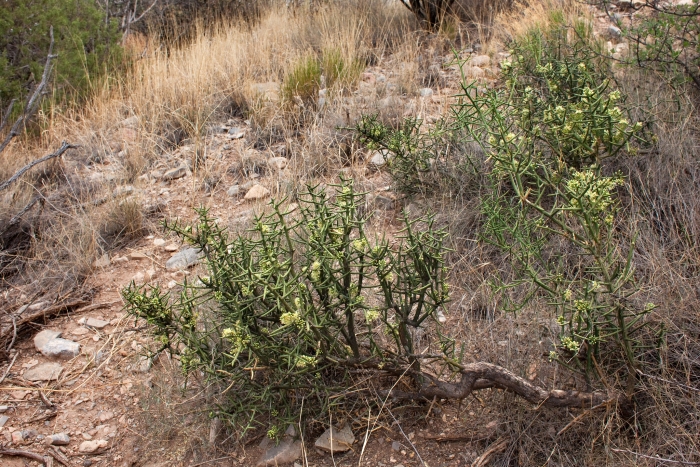Crown Of Thorns
(Koeberlinia spinosa)
Crown Of Thorns (Koeberlinia spinosa)
/
/

Patrick Alexander
CC0
Image By:
Patrick Alexander
Recorded By:
Copyright:
CC0
Copyright Notice:
Photo by: Patrick Alexander | License Type: CC0 | License URL: https://creativecommons.org/licenses/by/2.0 | Uploader: Josve05a | Publisher: Wikimedia Commons |























































Estimated Native Range
Summary
Koeberlinia spinosa, commonly known as Crown of Thorns, is a deciduous shrub or small tree native to arid regions such as deserts, grasslands, and scrublands in the Southwestern United States and Eastern Mexico. It typically grows to a height of 10-15 feet (3-4.5 meters) with a similar spread. The plant is characterized by its tangled, straight stems that branch frequently, ending in long, sharp spines. The leaves are reduced to tiny, deciduous scales, so most photosynthesis occurs in the green stem branches. Koeberlinia spinosa produces clusters of small, white to greenish-white flowers that are quite showy when in bloom, typically in the spring and summer months. The fruits are shiny black berries, each a few millimeters long, which are attractive to birds.
Crown of Thorns is valued for its unique, sculptural form and its ability to thrive in hot, dry climates, making it an excellent choice for xeriscaping and desert gardens. It is also used as a barrier plant due to its spiny branches. This plant requires minimal maintenance and is highly drought-tolerant, needing only occasional water once established. It prefers well-drained soils and full sun exposure. While generally disease-free, it can be susceptible to root rot if overwatered or planted in poorly drained soils. There are no widely known popular garden cultivars of this species. Gardeners should handle this plant with care due to its sharp spines and consider its potential to spread in favorable conditions.CC BY-SA 4.0
Crown of Thorns is valued for its unique, sculptural form and its ability to thrive in hot, dry climates, making it an excellent choice for xeriscaping and desert gardens. It is also used as a barrier plant due to its spiny branches. This plant requires minimal maintenance and is highly drought-tolerant, needing only occasional water once established. It prefers well-drained soils and full sun exposure. While generally disease-free, it can be susceptible to root rot if overwatered or planted in poorly drained soils. There are no widely known popular garden cultivars of this species. Gardeners should handle this plant with care due to its sharp spines and consider its potential to spread in favorable conditions.CC BY-SA 4.0
Plant Description
- Plant Type: Shrub
- Height: 8-15 feet
- Width: 6-12 feet
- Growth Rate: Moderate
- Flower Color: White, Green
- Flowering Season: Spring, Summer, Fall
- Leaf Retention: Deciduous
Growth Requirements
- Sun: Full Sun
- Water: Low
- Drainage: Medium, Fast
Common Uses
Drought Tolerant, Low Maintenance
Natural Habitat
native to arid regions such as deserts, grasslands, and scrublands in the Southwestern United States and Eastern Mexico
Other Names
Common Names: Allthorn, Crucifixion Thorn, Spiny Allthorn
Scientific Names: , Koeberlinia spinosa, Koeberlinia spinosa var. spinosa, Koeberlinia spinosa var. verniflora,
GBIF Accepted Name: Koeberlinia spinosa Zucc.